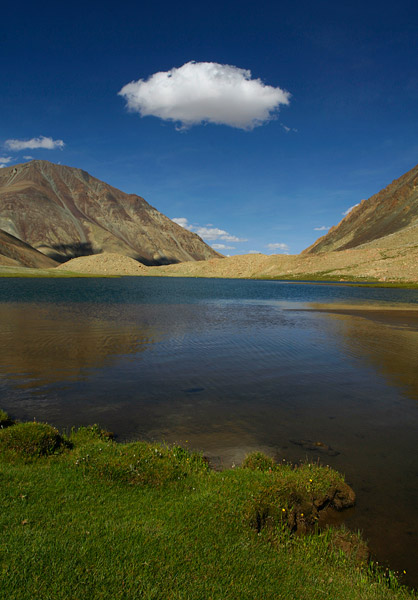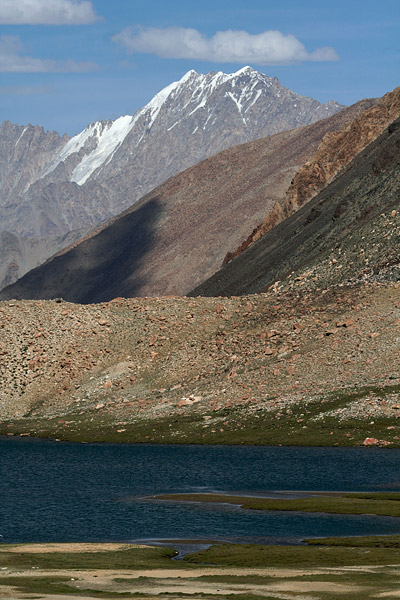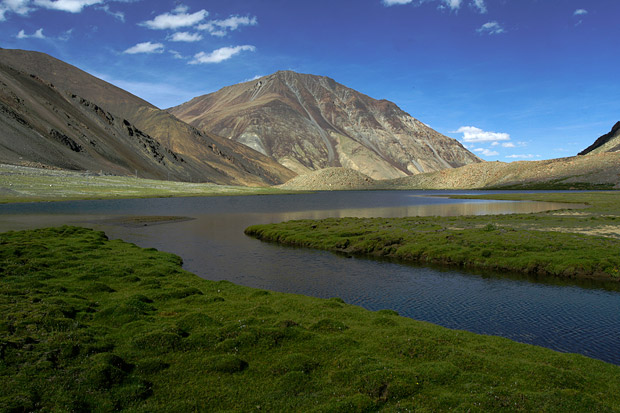The bike troubles were not meant to end soon. During the struggles in getting the bike up and running, the rare breaks had somehow stopped working. It was getting dark and there wasn’t much time left for us to inspect and fix the problem. We treaded in a slow pace using front-wheel breaks and made it to Thangse just before dark.
The break problem turned out to be easy to fix and took no more than a minute. But we had a bigger issue to address next morning.
We were warned earlier by jeep drivers about a stream-crossing few kilometres before Pangong Lake. The bridge across the stream had collapsed long ago, thanks to the ferocious currents. The stream would look like a pretty brook running down the mountain in the early hours, but as the day progressed and sunrays melted more ice on the slopes, water would rise to chest levels, making it impossible to cross. Its unpredictability had earned it the name ‘Pagal Nala’ – mad stream.
It seemed like a simple task to leave early from Thangse and make the 40-kilometer journey before the water level rose. But crossing a big stream usually came with its share of troubles. The path could be strewn by boulders, slippery rocks and shifting sands that could make things difficult. We had no idea how hard it would be, but there wasn’t an alternative but to try it out.
The road from Thangse turned out to be unusually green and beautiful. Excellent roads helped me forget the pains of riding and focus on the scenery instead. The narrow valley was filled lush grass, supported by a stream that ran in the opposite direction. The near-flat terrain occasionally became marshy with small streams criss-crossing the road. We saw cows and horses grazing peacefully on the way, their owners nowhere in sight. Himalayan marmots played in the grass with child-like enthusiasm. They would look cautiously from their hole before getting out to wrestle playfully with each other. I am told that the marmots have become tame enough to accept food from tourists in these parts, but none came up to us with a begging bowl. We were in a hurry as well, anxious to get across Pagal Nala before the water level started rising.
Water was less than a foot high when we got to the stream, but it didn’t look like an easy crossing. With the unpredictable nature of the nala, BRO made no attempt whatsoever even to make a temporary road across the stream. If they had ever done so, the mad stream has done sufficient hard work to ensure that there was no sign of it left.
A few vehicles were already parked near the nala before we got there. Some had given up and asked the tourists to walk across, while a few others were contemplating on crossing. The stream bed was a fifty-meter wide boulder strewn expanse with no definite clearing anywhere to let vehicles to pass. Two-wheel drive vehicles like Qualis and Innova made no attempts to get past, while a few Gypsys laboured hard over the stones.
I could not make up my mind on what to do next. A smaller bike would have had no trouble wading across the nala. You could simply push it across and even lift it over the stones if needed, but something like a Thunderbird came with its disadvantages. As we waited at the edge of the stream wondering at the next step, unsolicited advices came on our way. ‘You will never make it,’ said someone, while another said ‘it should not be a problem.’ An army officer in civilian clothes looked at us and said that we were attempting something suicidal. It did not look like an easy job in any case, but we decided to take the plunge.
We trod slowly and made it to half-way mark with some difficulty. It seemed like we will make it in no time, but quickly got stuck at the main channel, stopped by big stones that blocked our way. The bike too, decided that it is a good time to stop co-operating with us. Each time I started and revved the engine, it would struggle for ten seconds and go off again. For sometime, we were stuck on the main channel and risked the possibility of water entering through the silencer that was just an inch above the flow. Add to all this, the chill of the water was affecting my feet immersed in it as I tried to balance and support the heavy bike.
This repeated for a few minutes when the army officer took pity on us and came back to help. He ‘ordered’ us to dismantle all our luggage and instructed a jawan standing nearby to assist us. The jawan, with his perfectly polished leather shoes stood on a rock wanting to help, but couldn’t afford to get his shoes wet. As the engine failed to stay alive despite repeated attempts, he asked me to switch it off and wait for a few minutes. ‘The engine is heating up and going off,’ he told me, ‘wait till it cools a bit.’ This seemed to work and we were now guaranteed of the bike’s horse power. We managed to get across the main channel, but there were still many boulders to cross before we reached the other end. By this time, we must have spent good thirty minutes struggling in the middle. A few onlookers now came to help, pushing the bike bit by bit and getting it closer to the other side. A hefty jeep driver took over the bike from me and made the final effort to take it across. A big ordeal was over, but it was still not the end of all the troubles.
The struggles with pagal nala had left me tired and drained all my energies. Another smaller bridge a little ahead had recently given away and we were forced to tread slowly and carefully on an alternate track full of sand and gravel. Somewhere at the end of this dirt track, when we just got back to smooth tarmac road again, we had our first sighting of Pangong Lake.
The lake appeared as a small blue strip barely visible in the middle of the mountains. Its colours were of a superb deep hue that I had never seen anywhere else before. We had finally set sights on our destination. The effort, the struggle with starting the bike yesterday and efforts of getting across pagal nala were worth every single drop of sweat. It was moment of joy worth working for.
We struggled further for another half hour, riding through gravel, small streams and poor roads to reach Spangmik Village on the bank of the lake. The next three days were to be spent gazing at the lake and the mountains beyond, doing little else but admire the landscape.
We rode past the unnamed lake, descending steadily since we left Chang La. I turned off the bike’s engine and cruised gently downhill for nearly ten kilometers. When the road became nearly flat again and the bike lost its speed, I engaged the gears, trying to bring the engine into life. In response, instead of blasting Thunderbird’s trademark knocking sound, the bike coughed, sputtered and slowly came to a halt. We were in trouble!
By this time we had come nearly two hours away from Shakti, the last village on the other side of Chang La. The next village—Thangse—was thankfully not so far, but a good 30km away and too far to seek help. We were stranded in the middle of the mountains with a 200km monster of a bike that refused to do its job. It was already beyond 3pm and we did not have much time to find help before it got dark.
I made repeated attempts to kick-start the bike in the vain hope that it may show some mercy on us. If you have handled a Bullet, you know the kind of effort needed to coax one of those unwilling bike to life even in normal terrain. Out here in the mountains of Ladakh where the air is thin and slightest effort leaves you panting for breath, I had to give up in no time. An attempt to push-start did not work either. My first instinct was to look at the spark plug, but we did not have tools needed to take it out for inspection. Back in Leh when I hired the bike, I had asked the vendor to give me a tool kit. He had laughed in response and said, ‘what would you be able to do there if the bike breaks down? Just flag a truck and get it shipped back to Leh.’ He was more or less right: my knowledge of bikes was only slightly better than my knowledge of a space ship’s engine.
I resigned from all actions and let fate decide the next course of action. The only thing I could think of doing was to stay optimistic. Perhaps someone nice would come on the way and help us out, a truck might take us to Thangse where someone from the army might be able to look at it, or at best a jeep driver passing by would inspect the bike and bring it back to life.
Thankfully, it did not take long for help to arrive. It was hardly five minutes before a truck arrived from the opposite direction. The driver stopped to ask what the problem was, and pulled over to take a look at the bike. In the next hour or so, I was to see how helpful the people in these parts can be. The driver and a bunch of labourers in the truck struggled to get the bike working, as if it is their own problem.
Everyone took their turn inspecting the bike and trying to kick-start the engine, but nothing much happened. It roared once a while and got me excited, but would not last more than a few seconds before it went silent again.
I had presumed that they would try for a few minutes before giving up and offering us to load the bike into the truck and take it back to Shakti Village or Leh. But the stayed on, trying to help us with the bike for more than an hour. In the meanwhile, we discussed our choices, which included staying at a parachute tent a little ahead for the night or to get back to Shakti on the truck.
We could not really come to a consensus on staying at the parachute tent. Waking up next morning, we would be in no better position than today and may have no choice but to take a truck back next morning. It would be a pointless effort. Going back with the truck was an easy thing to do, but having come three-fourth the way to Pangong, that would cause a terrible disappointment.
I have a disease that sometimes surfaces when I am in faraway places, especially in the mountains. When I am closer to the destination where an excitement awaits me, few things can force me to stop and head back. The thoughts of disappointment that I would suffer later keep me going and do all that I can to reach the destination. A few years ago, when I was on a 6-day trek to Goecha La pass in Sikkim, I was in a similar situation where I had difficulty in walking the last few kilometers to the pass. It was my first Himalayan trip and the cold was troubling me. I felt mildly feverish the night before and had decided not to walk the last stretch. But next morning, I found myself unable to hold back and decided to walk slowly to the destination. I must have taken thrice the normally required time, but had finally made it to the pass.
A similar emotion conquered me on the way to Pangong. I would not have been able to take the disappointment of not visiting the lake. So we kept toying with our options though it would have been prudent to load the bike in the truck and head back. As the workers continued their effort to start the bike, we struck a conversation with the truck driver. Like most people who come to Ladakh from outside for work, he too did not seem to like the place much. ‘What is there to see in Ladakh? Why do you come here?’ he asked us repeatedly. He continued, helpfully suggesting us of a better place to visit. ‘Go to Chumathang,’ he said, ‘you will see hot water coming out of the ground there!’ Srinagar was another place he thought was worth a visit. ‘It is green and beautiful,’ he said, ‘the mountains are all bare in Ladakh.’
As the bike did not seem to come alive even after an hour, I drifted away from the problem and into the scenery around. A stream ran parallel to the road, carrying clear waters from the snow-melt. Lush grass and an eruption of purple flowers spread on a thin line at the edge of the water. It was a narrow valley with stark slopes on either side, with just one tall snowy peak glowing in the evening light. I was instantly in love with the place and wished I could spend the night right there.
In the meanwhile, a decision was finally made to put the bike on the back of the truck and head back to Shakti Village. It looked like there was no other choice left. Several hands joined together as we tried to lift the bike up. But the Thunderbird is no small bike and it is not easy for even half-a-dozen people to lift it by 5 feet. The task at hand was not easy and we had to give up and look for smarter ways to get the bike into the truck.
We made another attempt at starting the bike again, without much success. But even at a time when they tried all that they can and there was nothing much to be done, the truckers stuck with us and pondered on possible options instead of moving on and leaving us to handle the problem ourselves.
A bunch of bikers arrived as we were pondering on what to do. As luck would have it, one of those guys happened to be a mechanic. He spent a few minutes with the bike and quickly unearthed a loose-contact in the wires connecting the spark plug. The next moment, as if by magic, the thundering sound of Thunderbird filled the valley like music to my ears!
We continued our journey towards Thangse along with other bikers. But as it turned out, our troubles with the bike was far from over!
Even when the heavy bike troubled me a great deal, I manage to keep my eyes open to the sights around me as we drove past Chang La.
Leaving Karu Village after a breakfast of Alu Parathas, we rode past the village of Shakti before the climb to Chang La began. If there is a village anywhere in Ladakh, there has to be monastery perched high on a crag somewhere nearby. Sure enough, there was Chemrey Monastery visible far away on the mountain slopes.
We climbed steadily keeping a deep valley and Shakthi Village to the left and the mountains to the right. Tall jagged snow-peaks of Zanskar Ranges showed up beyond the Indus Valley when I stopped at an army check-post before Chang La and looked back at the valley we had left behind.

At 17,360 feet, Chang La was cold but the shining sun and absence of wind kept us in comfortable. Nevertheless, the thin mountain air and the struggles with the bike had tired me out and I was looking forward to the descent and better roads ahead. The landscape changed considerably after the pass. The valleys were wider and the slopes were gentle. There was a burst of green grass on the earth, which was a remarkable change from the arid slopes on the other side. There was more life too. Himalayan Marmots ran around playfully in the grass and wrestled with each other as we rode past them. Wild rabbits disappeared into their holes when they saw us. Where the slope was gentle, the grass was so thick and green that it completely hid the brown colour of the soil.

All this was great, but the greatest moment on the road came when we stumbled upon an open area with a deep blue waterbody in the middle of it. A stream that flowed from down from Chang La spread open on a grassy expanse and its blue waters reflected the mountains surrounding it. Tiny yellow and white flowers spread densely in small patches amidst the green grass. Occasional clouds that passed above the mountains reflected in the lake, creating distraction in the blue plane. The water was so clear that we could see the pebbles at the bottom as clearly as if there wasn’t any water. In the arid landscape of Ladakh, this was the first time I was seeing a natural lake so attractive that its serenity made the journey feel complete much before the destination was reached.

Nevertheless, the destination—Pangong Tso—still had to be reached and we were to find out soon that it involved a lot of struggle!


